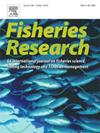对斯里兰卡家庭鱼类和海鲜消费进行量化的第一次全岛调查
IF 2.2
2区 农林科学
Q2 FISHERIES
引用次数: 0
摘要
在斯里兰卡,作为一个岛国,海鲜是饮食中不可或缺的一部分,是蛋白质和营养素的重要来源。然而,它也被认为是人类接触污染物的途径,因此风险效益评估对于优化海鲜消费至关重要。这项研究旨在解决斯里兰卡家庭鱼类和海产品消费率数据不足的问题,同时分析消费模式及其决定因素。在全国范围内进行的网络调查显示,97% %的受访者(n = 2149人中有2078人)食用海鲜,平均139.69 g天−1人−1。沙丁鱼的食用量最多(93 %),海藻的食用量最少(1 %)。罗非鱼、黑头鱼、大虾、鲤鱼等淡水鱼也很受欢迎。99 %的受访者在购买鱼和海鲜时最关心的是新鲜度。海产品对斯里兰卡人的每日蛋白质需求贡献很大,占斯里兰卡人每日蛋白质需求的48% %,这强调了了解海产品消费参数对未来风险效益评估的重要性。此外,该研究还调查了鱼类和海产品的消费模式、行为、决定因素和海产品过敏,以更好地了解斯里兰卡海产品消费率的影响。本文章由计算机程序翻译,如有差异,请以英文原文为准。
The first island-wide survey on quantifying household fish and seafood consumption in Sri Lanka
In Sri Lanka, as an island nation, seafood is integral to the diet, serving as a crucial source of protein and nutrients. However, it is also considered a pathway for human exposure to contaminants, making risk-benefit assessments essential to optimize seafood consumption. This study aimed to address the lack of data on household fish and seafood consumption rates in Sri Lanka, while also analysing consumption patterns and their determinants. Conducted through a web-based survey across the country, it revealed that 97 % of respondents (n = 2078 out of 2149) consumed seafood, averaging 139.69 g day−1 person−1. Sardinella species were the most widely consumed (93 %), while seaweeds had the lowest consumption (1 %). Freshwater fish including tilapia, snakehead fish, giant freshwater prawn, and carps were also popular. Freshness emerged as the primary concern for 99 % of respondents when buying fish and seafood. Seafood contributed considerably to daily protein requirement, constituting 48 % of the daily protein needs for Sri Lankans, emphasizing the importance of understanding seafood consumption parameters for future risk-benefit assessments. Additionally, the study investigated fish and seafood consumption patterns, behaviours, determinants, and seafood allergies to gain a better understanding of the implications of seafood consumption rates within the Sri Lankan context.
求助全文
通过发布文献求助,成功后即可免费获取论文全文。
去求助
来源期刊

Fisheries Research
农林科学-渔业
CiteScore
4.50
自引率
16.70%
发文量
294
审稿时长
15 weeks
期刊介绍:
This journal provides an international forum for the publication of papers in the areas of fisheries science, fishing technology, fisheries management and relevant socio-economics. The scope covers fisheries in salt, brackish and freshwater systems, and all aspects of associated ecology, environmental aspects of fisheries, and economics. Both theoretical and practical papers are acceptable, including laboratory and field experimental studies relevant to fisheries. Papers on the conservation of exploitable living resources are welcome. Review and Viewpoint articles are also published. As the specified areas inevitably impinge on and interrelate with each other, the approach of the journal is multidisciplinary, and authors are encouraged to emphasise the relevance of their own work to that of other disciplines. The journal is intended for fisheries scientists, biological oceanographers, gear technologists, economists, managers, administrators, policy makers and legislators.
 求助内容:
求助内容: 应助结果提醒方式:
应助结果提醒方式:


